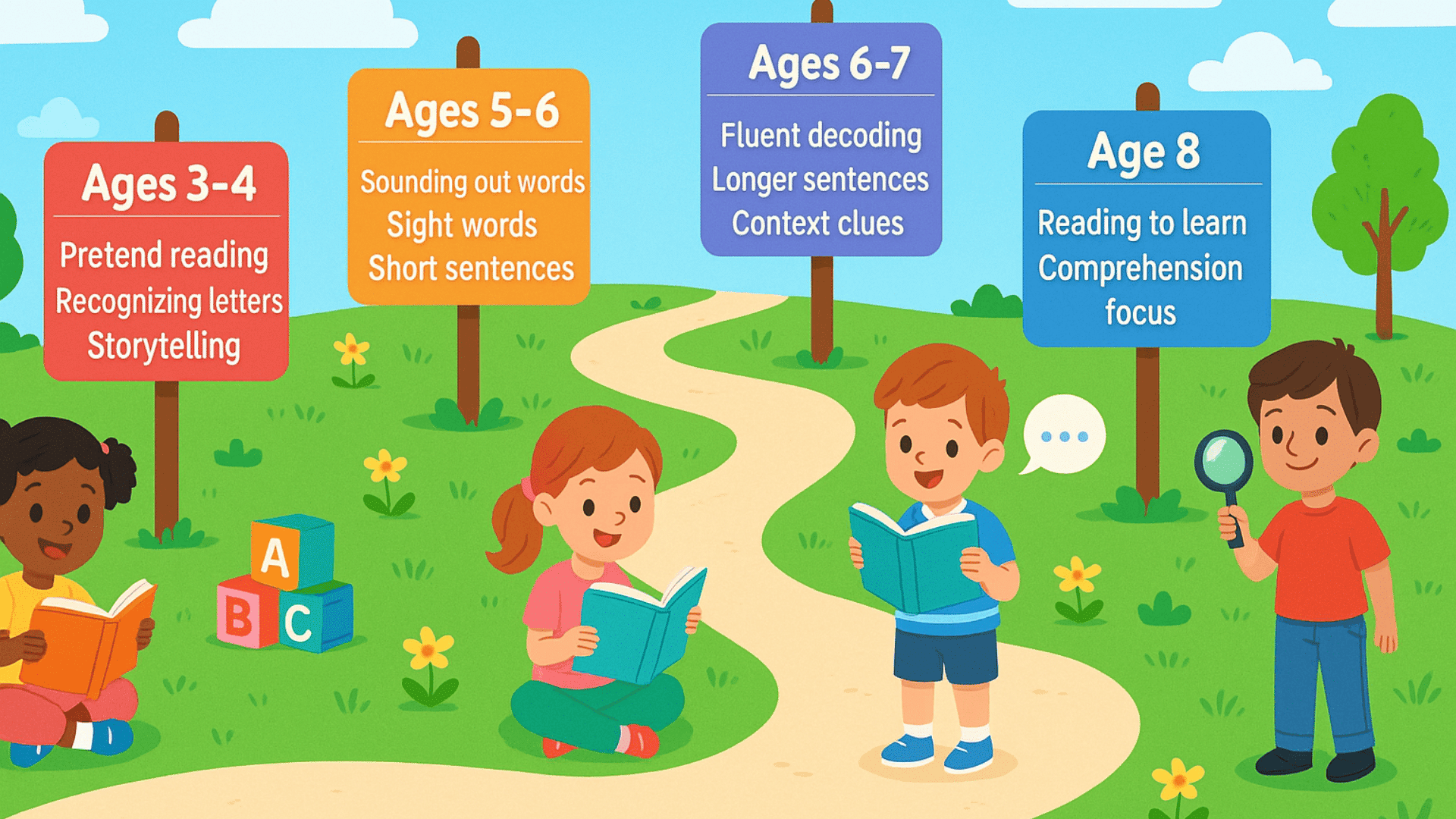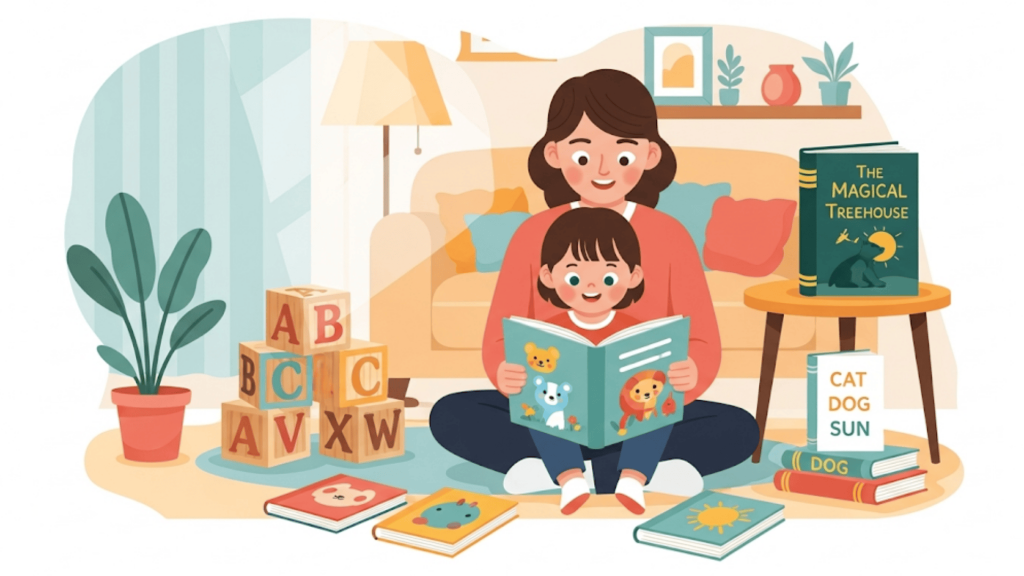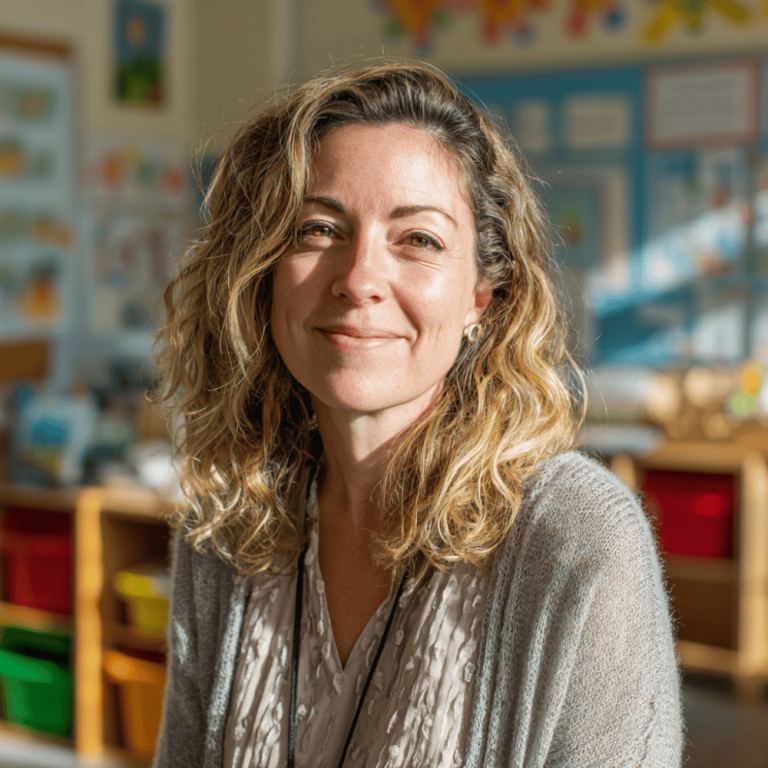I’ve always believed that reading is one of the most important skills a child can learn. It doesn’t happen overnight, but step by step, as kids grow and practice.
Many parents often wonder, what age do kids start reading? The truth is, every child follows their own path, but the process usually begins with learning to read – recognizing letters, sounding out words, and putting together short sentences.
Later, children move into reading to learn, where books become tools to understand new ideas and the world around them.
In this blog, I’ll walk you through the stages of reading, signs that show your child is ready, and simple ways parents can help at home.
The Reading Path: Learning to Read vs. Reading to Learn
Reading doesn’t happen all at once. It’s a step-by-step process that builds over time. Kids don’t just wake up one day knowing how to read.
This is the key difference:
- Learning to read (ages 3–7): This stage is about cracking the code. Kids learn to recognize letters, sound out words, and start using phonics. They also begin to spot simple words and put sentences together.
- Reading to learn (around age 8+): Once the basics are mastered, reading becomes a powerful tool. Kids use it to understand stories, gather information, and learn about the world around them. Fluency and comprehension take center stage.
The shift from “learning to read” to “reading to learn” is a big milestone. It’s when reading turns from a skill into a doorway for new knowledge.
When Do Kids Start Reading?

Children typically progress through reading stages, and each age level introduces new skills. These milestones don’t happen overnight but grow slowly as kids gain confidence and practice.
Around ages 3–4, many children show early signs of reading. They may pretend to read, retell stories, or recognize some letters while enjoying picture books.
By the ages of 5–6 (kindergarten), most children can connect letters with sounds, sound out simple words, recognize sight words, and read short sentences.
Between ages 6 and 7, kids become more fluent, decoding longer words, reading smoothly, and using context clues.
By age 8 (third grade), many shift from “learning to read” to “reading to learn,” focusing on comprehension
It’s also important to remember that some children begin earlier, around 3 or 4, while others may not be confident until 7 or 8. Both timelines can still be normal. Every child follows their own pace on the path to becoming a reader.
Signs Your Child is Ready to Read
Before kids start reading on their own, there are a few signs that show they’re getting ready. These small steps tell you their brain is building the foundation for reading:
- Interest in books and stories: They enjoy flipping through books or asking you to read aloud.
- Recognizing letters, sounds, or their own name: They can point out familiar letters or pick their name from a list.
- Pretend play that involves “reading”: They hold a book and pretend to read, or make up stories from pictures.
- Asking about letters, words, or spelling: Curiosity kicks in, and they want to know how things are written.
- Longer attention span: They can sit and listen to a story from start to finish.
These early signs don’t mean they’ll start reading right away, but they show your child is on the path and ready to take the next steps.
How Parents Can Support Early Literacy
Parents play a significant role in helping children develop early reading skills. You don’t need to be a teacher to make a difference; some daily habits and a few available resources can help you out more.
Ideas to Support At Home
Helping your child with reading doesn’t need to feel complicated. Small, everyday habits at home can make a big difference in building literacy. A few are listed below:
- Read aloud daily: Share books together. This builds vocabulary, listening skills, and a love of stories.
- Play letter and sound games: Use alphabet blocks, sing rhyming songs, or match letters with sounds.
- Try interactive storytelling: Let your child retell a story or “read” a book back to you using pictures.
- Create a print-rich environment: Label everyday items at home and keep age-appropriate books within reach.
- Offer book lists by age: Choose books that fit your child’s stage. A list for ages 3–8 can make it easier.
With these small steps, reading becomes an enjoyable and natural experience, rather than a forced one. Kids learn best when they enjoy the process.
Resources for Parents
You don’t have to handle the reading journey all on your own. There are also many trusted groups, apps, and tools designed to help parents guide kids step by step.
The right resource can make reading practice easier, more fun, and less stressful for the whole family:
| Type of Resource | Examples & Links | How It Helps |
|---|---|---|
| Literacy organizations | Reading Rockets, Scholastic Raise a Reader, and Local libraries | Free tips, expert guides, book suggestions |
| Apps & tools | Epic – digital kids’ library Starfall – phonics games ABCmouse – step-by-step early learning Raz-Kids – leveled online books |
Makes practice fun, supports phonics, and early fluency |
| Printables | Milestone checklists, age-based book lists | Track progress, pick the right books by stage |
These resources provide parents with clear guidance and engaging options, making reading practice feel natural and enjoyable.
Different Reading Paths Kids May Take
Children don’t all learn to read at the same pace. Some pick it up early, while others need more time and support. Both paths are normal, and knowing what to look for can help parents guide their child.
Early Readers: What If My Child Starts at 3–4?
Some children show interest in reading much earlier than others. This can feel exciting, but it’s essential to maintain a positive and stress-free experience.
- Nurture without pressure: Celebrate their curiosity, but don’t push them to move faster than they want.
- Know the difference: Some kids memorize favorite words or books, while true reading means sounding out and understanding new words.
- Keep it fun: Offer picture books, word games, or let them act out stories. The goal is to build joy, not just skills.
Early readers thrive best when learning feels playful and relaxed.
When Kids Struggle to Read (Problem-Solving)
Some children require additional support before reading becomes a fluent and automatic process. Knowing what to watch for helps parents step in early.
- Red flags: If there’s little progress by the ages of 7–8, or if your child avoids reading, becomes frustrated, or shows no interest, it may be time to take a closer look.
- Possible causes: Struggles can stem from vision problems, dyslexia, or insufficient exposure to books and reading activities.
- Steps to take: Talk with your child’s teacher. Consider seeking a professional evaluation, working with a reading specialist, and utilizing school resources.
Early help makes a big difference. Children who get the right support often catch up quickly and start to enjoy reading again.
With patience, encouragement, and consistent practice, even struggling readers can gain confidence. Over time, they build the skills they need to read independently and succeed in school.
Age-Based Book List for Kids (3–8 Years)
The right books can spark a child’s interest and keep them excited about reading. Selecting age-appropriate stories makes the process easier and more enjoyable for both children and their parents.
| Age Range | What Kids Enjoy | Recommended Books |
|---|---|---|
| Ages 3–4 | Picture-heavy stories with rhythm and rhyme. | Brown Bear, Brown Bear, What Do You See? – Bill Martin Jr. & Eric Carle Goodnight Moon – Margaret Wise Brown Chicka Chicka Boom Boom – Bill Martin Jr. & John Archambault |
| Ages 5–6 (Kindergarten) | Simple, repetitive text with sight words. | Hop on Pop – Dr. Seuss Pete the Cat: I Love My White Shoes – James Dean & Eric Litwin Are You My Mother? – P.D. Eastman |
| Ages 6–7 (Grades 1–2) | Longer sentences, short chapter books, and humor. | Frog and Toad Are Friends – Arnold Lobel Henry and Mudge series – Cynthia Rylant Amelia Bedelia – Peggy Parish |
| Age 8 (Grade 3) | Independent reading with deeper stories and characters. | Charlotte’s Web – E.B. White Magic Tree House series – Mary Pope Osborne Judy Moody series – Megan McDonald |
Books like these grow with your child, matching their reading skills step by step. Having the right stories at the right time makes reading feel natural, fun, and rewarding.
Where to Buy
Finding the right books is easier when you know where to look. Here are a few trusted places where you can find the titles listed above:
- Local bookstores: Many independent shops carry children’s classics and can also help you order specific titles.
- Libraries: A free and valuable option. Most libraries have large children’s sections with many of these books available to borrow.
- Online retailers: Websites like Amazon, Barnes & Noble, or Bookshop.org usually stock all of these titles. Bookshop.org is a great choice if you’d like to support local bookstores while shopping online.
- Secondhand options: Thrift stores, Facebook Marketplace, or used book sites like ThriftBooks are budget-friendly ways to build your child’s library.
Regardless of where you purchase, prioritize selecting books that align with your child’s current developmental stage. Having the right story at the right time keeps reading fun and helps skills grow naturally.
Conclusion
I’ve learned that reading doesn’t happen on a fixed timeline, and your child’s reading path may look different from mine. What matters most is giving them steady encouragement and keeping books a part of daily life.
With patience, you can help your kids become confident readers. Every small step counts, whether it’s reading aloud, going through age-appropriate books, or simply making storytime fun.
Some children may start early, while others take longer, but both paths can still lead to strong, independent reading skills.
If you found this helpful, I’d love for you to check out more of our blogs for practical tips and parent-friendly advice on supporting your child’s growth.











